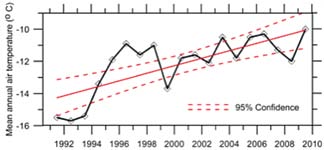Konrad Steffen

Dr. sc. nat. ETH, Swiss Federal Institute of Technology
(Zürich), 1983
CIRES Director, 2005-2012
Professor Emeritus of Geography
E-mail: konrad.steffen@colorado.edu
Web: Konrad Steffen Research Group
Research Interests
My general interest is the study of processes related to climate and cryosphere interaction in polar and alpine regions based on in-situ and satellite measurements, and using climate system modeling to study their sensitivity. In particular I study and evaluate sea level changes and sensitivity studies of large ice sheets using in situ and modeling results. Most of this research is supported by the NASA/NSF initiative called PARCA: Program in Regional Arctic Climate Assessment.
Current Research: Greenland Climate Network and Swiss Camp Climatology
— with graduate students Daniel McGrath, William Colgan, Thomas Phillips, and Nicolas Bayou
The Greenland Climate Network (GC-Net) was established in spring 1990 with the intention to monitor climatological and glaciological parameters at various locations on the Greenland Ice Sheet over several decades to study the climate variability. The first automatic weather station was installed at the Swiss Camp on the western slope of the Greenland Ice Sheet in spring 1990, followed by four automatic weather stations in 1995, four in 1996, five in 1997, four in 1999, one in 2002 and 2003, and the latest one at the European/U.S. deep-icecore site in northwestern Greenland in 2006. The long-term objectives for the Greenland weather station network are to measure daily, annual, and interannual variability in accumulation rate, surface climatology, and surface-energy balance at selected locations on the ice sheet, and to measure near-surface snow density at the GC-Net locations for the assessment of snow densification, accumulation, and metamorphosis.

Figure 1: Interannual variability of monthly mean air temperatures (1991-2009) at the Swiss Camp, located at the equilibrium-line altitude on the western slope of the Greenland Ice Sheet.

Figure 2: Interannual variability of monthly net radiation (W/m2) at the Swiss Camp (1993-2009).

Figure 3: Interannual variability of monthly mean albedo at the Swiss Camp (1993-2009).
GC-Net data requests from the beginning of 2009 to the present came from 184 individual users for surface process studies, model validation, and satellite intercomparison. The web interface allows us to capture the email and affiliation of all GC-Net users, including a short description of their use of the Greenland Climate data. Data requests are processed on a UNIX 4-processor workstation and datasets are transferred on a FTP site for direct downloading.
The mean annual air temperature at Swiss Camp is -12.3°C (1991-2009), with the coldest monthly temperature in February (-32°C) and the warmest monthly temperature in July (+1.8ºC). Summer mean monthly temperatures above freezing occurred in 1995 and from 1997 to the present. The mean annual temperature has increased by 4.0°C (about 2°C/decade) using a linear regression model as shown in Figure 1. The temperature minimum in 1992 was the result of the aerosol loading caused by the Mt. Pinatubo eruption. The linear regressing model at 95-percent confidence shows that the Pinatubo cooling and the subsequent warming from the mid 1990s were outside the 95-percentconfidence level. The warming that occurred since 2000 to present shows approximately the same trend as the 19-year time series. The warmest mean annual temperatures were -10.0°C and -10.3°C in 2009 and 2006, respectively.
Radiation has been monitored continuously at Swiss Camp since 1993. The largest monthly mean net radiation is found in the summer of 2007 (> 60 W/m2), coincident with air temperatures above freezing, indicating a strong albedo-feedback mechanism at the equilibrium line altitude (Figure 2). Most of the annual snow cover melted and the bare ice surface was exposed, reducing the monthly albedo value to 0.4 (Figure 3).
It is worth discussing the three anomalous periods of 1995, 1998, and 2001-2009 (Figure 2). The summer season is characterized by a positive net radiation flux, which is indicative of the length of the melting season. High net radiation values can either be the result of low albedo values (i.e., 2003-2009, Figure 3), reduced cloudiness (increase in insolation), or increase in atmospheric temperatures (increase in long-wave radiation). The mean summer net radiation has been higher during the new millennium (30 W/m2) compared to the previous decade, with the exception of record high values in 1995, as a result of increased atmospheric temperatures leading to increase in surface melt (albedo reduction).
Publications
Click here for a complete list of published works »
Dr. Steffen is a member of the CIRES Professor.

